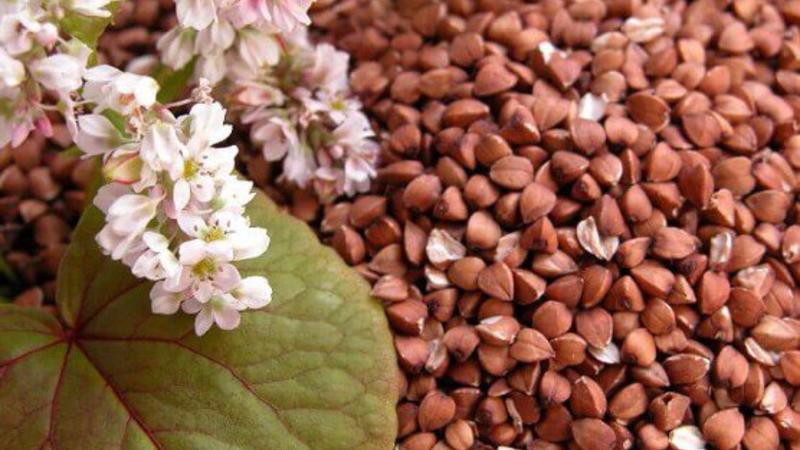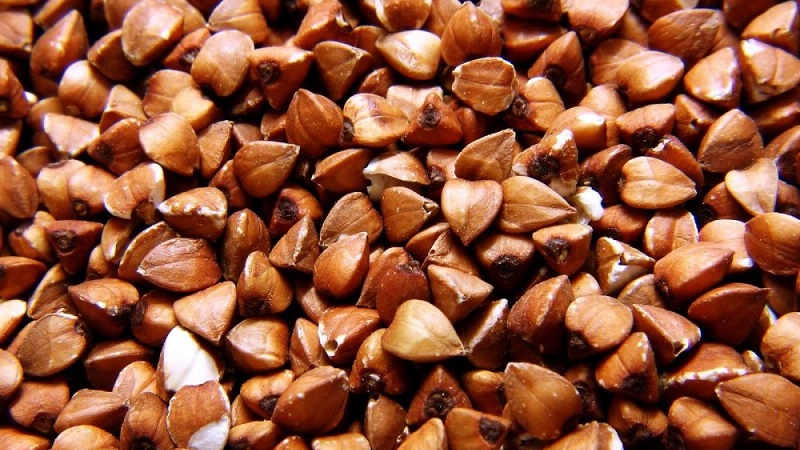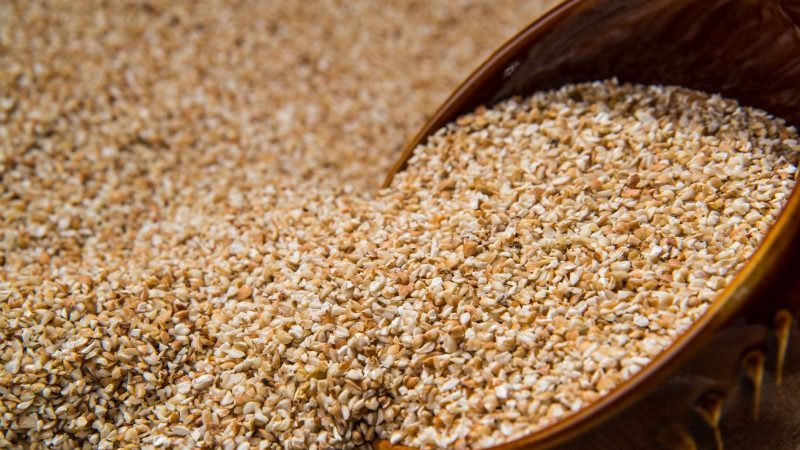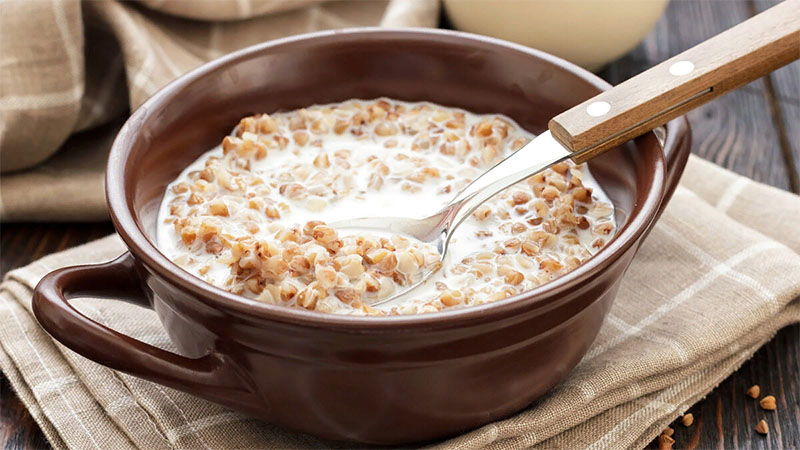Description of buckwheat groats, its relationship with buckwheat and buckwheat porridge
Buckwheat groats are the fruits of sowing buckwheat, herbaceous culture of the Buckwheat family. Its seeds spread in food culture not only in humans, but also in animals about 5 thousand years ago. The highlands of the Himalayas are considered the homeland of buckwheat, where its wild forms still grow. Consider what buckwheat is and what its varieties exist.
The content of the article
Characteristics and description of buckwheat

Buckwheat is small triangular nuts (buckwheat fruits) of brown, light brown or green color. They are covered with a dense shell - husk. The crop is resistant to many types of weeds and is characterized by high yields.
Buckwheat has a rich chemical composition. Vitamins:
- groups B: B1, B2, B4, B5, B6, B7, B9;
- E;
- beta carotene;
- PP;
- K;
- lutein and zeaxanthin.
Minerals:
- potassium;
- calcium;
- silicon;
- magnesium;
- sulfur;
- phosphorus;
- chlorine;
- boron;
- iron;
- iodine;
- lithium;
- manganese;
- copper;
- molybdenum;
- selenium;
- chromium;
- zinc;
- zirconium.
Groats contain up to 14% protein. The amino acids are balanced. Of the fatty acids, oleic, linoleic and linolenic acids prevail. The product is classified as low-calorie: the energy value of raw kernel is about 343 kcal per 100 g, boiled - 130 kcal.
There is no gluten in buckwheat. Therefore, it is allowed for people with gluten allergies.
Various types of cereals

Depending on how the raw material is processed (steaming, crushing, etc.), there are several varieties of cereals. First, the kernels are separated from the thin shell, then steamed. As a result, the product acquires the usual brown color of various shades.
Reference. What are the differences between buckwheat and buckwheat groats? They do not exist: buckwheat itself is called buckwheat, and cereals, and porridge.
Buckwheat fruits, not steamed, have a light creamy shade with a yellowish or greenish tint. Such cereals are considered the most useful, since vitamins and minerals are preserved in it as much as possible.
Core

Core Are whole brown, steamed buckwheat grains, triangular in shape, separated from the husk. Groats are considered 1 grade, as they are made with minimal mechanical processing. It is used both raw and lightly fried.
Porridge, which is prepared from the kernel, normalizes metabolism, helps to get rid of excess weight, removes toxins from the body.
Chopping

A cut, or done, - the same unground, only crushed into several parts (2 or more). During production, the raw materials are passed through a special sieve to separate the main products from the fine fraction of grinding. When crushed, the section loses its original triangular shape, therefore it belongs to grades 2 cereals and costs less than a kernel.
Important! Prodel is suitable for baby food, as it quickly boils down and does not lose its beneficial properties.
In the East, buckwheat, in addition to the usual dishes, is used to make tea. It is especially popular in China. Tatar buckwheat is used for the preparation of such a drink.
Smolensk buckwheat
Smolensk buckwheat is one of the smallest cereals, comparable in size to poppy seeds. They make it from a crushed cut. Raw materials are passed through a sieve to separate finely ground cereals from flour dust. The result is light brown grains. This type of cereal belongs to the 3rd grade and costs less than a kernel and a piece.
Smolensk buckwheat is suitable for dietary and baby food, cooking viscous porridge and baking.
Green buckwheat

Green buckwheat do not undergo heat treatment.During the production process, cereals are cleaned from the outer shell and immediately packaged for sale. Such a product retains more vitamins, minerals and flavonoids.
For greater preservation of nutrients, this type of buckwheat is best consumed raw, and soaked in water or milk for swelling.
Reference. Flavonoids (rutin, quercetin, vitexin, isovitexin, orientin and isoorientin) are found mainly in buckwheat itself. There are few of them in the grains; most of them are lost during processing. However, these substances are retained in buckwheat seedlings.
Green buckwheat is suitable for planting; under optimal conditions and care, it sprouts.
Buckwheat flour
Buckwheat flour is made from chaff or fine fraction of kernel. The ingredients are thoroughly ground to a dust-like consistency. Flour belongs to the 1st grade and is widely used in cooking. Due to the lack of gluten, it is used as an addition to bread baking.
Buckwheat flour lowers cholesterol levels, oxygenates the blood, helps to normalize nutrition and reduce the calorie content of food.
What cereals are used to make buckwheat porridge

Buckwheat porridge usually boiled from a whole kernel. In addition, casseroles, cutlets, soups, puddings, etc. are prepared from it. Most often, porridge is made in milk, but to reduce the calorie content of the finished dish, it is better to use water.
What is the difference between buckwheat and buckwheat porridge? Nothing: from cereals (kernel, prodel, Smolensk) they get porridge of different consistency.
The product is full of complex carbohydrates - cooked meals leave a feeling of fullness for a long time, but do not lead to weight gain.
Important! If the cereal has a bright brown color with a red tint, it cannot be used. This color scheme indicates that the raw materials were heavily fried during production. Therefore, it contains the minimum amount of nutrients. The right choice would be buckwheat of a light brown uniform color with even kernels.
For all the benefits, the product has some contraindications. It is not recommended for people with increased blood clotting, as it increases its viscosity. However, this only happens if you eat one buckwheat for a week or more. With a varied diet, the circulatory system is not in danger.
Groats are contraindicated in case of individual intolerance. It is advisable to use buckwheat in moderation during pregnancy and breastfeeding to eliminate the risk of allergies.
Conclusion
Buckwheat is a valuable source of complex carbohydrates and protein. Hearty and healthy product is suitable for lactating women, children, people with diabetes and high blood pressure.
Industrial technology for processing buckwheat fruits allows you to get several types of cereals: kernel, propelled, Smolensk buckwheat.